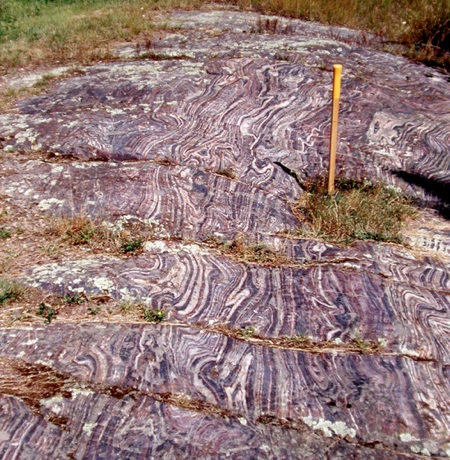Technology, a Geological Force
The theory of “mineral evolution” — the idea that the Earth’s rocks are dynamic “species” which emerged over time, sometimes in concert with living things — is a radical new idea introduced by this paper. The theory, called Mineral Evolution, states that:
Biochemical processes may be responsible, directly or indirectly, for most of Earth’s 4300 known mineral species.
According to this theory, life is a geological force. Life has shaped the physical shape and form of the rocky planet we live on. Life, a standing wave of ephemeral organisms, each one who lives a nano-second in geological time, shapes the seemingly eternal rocks beneath them. It is not just layers of pre-living organisms in marble and limestone, but the very mountains may be influenced by life.
The paper offers a brief timeline of the accumulation of species on Earth in geological time might look like this.
60 species of mineral >4.56 Ga (mostly chondrites — the material found in meteorites)
250 species of mineral 4.56 — 4.55 Ga (achondrites and iron)
350 species of mineral 4.55 — 4.0 Ga (igneous rock)
1000 species of mineral 4.0 – 3.2 Ga (granitoids, primitive granites)
1500 species of mineral 3.2 — 2.8 Ga (new sulfate ores, due to plate tectonics and first life)
4000 species of mineral 2.5 — 1.9 Ga (great oxidation)
4300 species of mineral 0.54 > now (calcites, dolomite, opal and clays)
By this account, there are 3 stages to mineral evolution. (The primary author Robert Hazen uses the term evolution to mean progressive change, rather than natural selection. )The first is the progressive separation of elements from the primordial mix of the original gas nebula before the planets and sun formed. Elements like carbon, silicon separate and recombine to form basic building blocks. The second stage is geological pressure and temperature and chemical oxidation upon these blocks, which produced new minerals. The third stage is “the generation of far-from-equilibrium conditions by living systems” which unleash a multitude of new mineral forms.
Thus biology began to affect the Earth’s surface about 3.8 Ga when life changed its atmosphere and ocean chemistry, precipitating out carbonate and iron formations. Later around 2.2 to 2.0 Ga, during the “great oxidation event” the rise of multicellular life yielded massive amounts of skeletal biomineralization (limestone, dolomites, marbles, shales, etc.), which in turn, transformed the surface minerals on the planet.

An example of pre-oxidation life making minerals are these Iron banding rocks formed 2.5 to 4 billion years ago (Ga). Image from Hazen.
According to this article about Hazen’s theory,
As the materials that formed Earth “clumped” together and were subject to thermal pressures and other forces, the number of distinct minerals increased to about 250, the study says. Then, due to volcanic activity, plate tectonics and other processes that churned the surface of the planet before life emerged, the population of mineral “species” had grown to about 1,500 by four billion years ago. That’s when changes to ocean chemistry and atmospheric conditions, coupled with the emergence of life, sparked an unprecedented diversification of the world’s minerals.
“For at least 2.5 billion years, and possibly since the emergence of life, Earth’s mineralogy has evolved in parallel with biology,” Mr. Hazen added. “One implication of this finding is that remote observations of the mineralogy of other moons and planets may provide crucial evidence for biological influences beyond Earth.”
In other words, one might be able to detect life on other planets by looking at the planet’s mineral diversity, which, like its atmosphere, may be detectable from a great distance.
But if the mineralogy of a terrestrial planet evolves as a consequence of a range of physical, chemical, and biological processes, then why should it stop with natural life?
We should expect that over the very long term, if technology continues to increase its presence and scope, our planet will see anthropogenic rock. Technology will produce species of minerals birthed via technological pollution, or by products of agriculture and manufacturing. Indeed, since agriculture has been affecting the Earth for at least 10,000 years, we may be able to find the first evidence of anthropogenic minerals in soils disturbed by tilling, or layers of dust liberated by constant plowing or over-grazing, or in deposits from salt generated by over-irrigation. In the long-term perhaps layers of plastic in landfills, or exposure to acid rain, or sulfur particulates may clump into some new kind of mineral under pressure. These minerals can also form far from the centers of technology, because the lithosphere, like the biosphere, is a complex system of interacting forces.
Just as it may be possible for us to learn how to detect life on a planet by the detecting the presence of certain biogenic minerals, it may also be possible to detect technology by the presence of technogenic minerals. In some cases, the technogenic minerals may be all that is left of a technological civilization.


